No Wucking ForriesThe Third Californian Independent Armoured Brigade was typical of the forces used by the North Western Forces (NWF) arm of the Combined State Alliance forces during the Second United States Civil War. As with other forces rapidly cobbled together in the early days of the war, this was initially thrown together from elements of the California and Oregon National Guards, defecting US Army and Marine Corp units as well as local civilian militias including a healthy dose of civilian volunteers. Apart from the equipment brought with the defecting units, this unit also benefitted from the liberated equipment stored at localities such as Sierra Army Depot (SIAD).
Initially fighting with existing equipment, as the war continued into its second year, it became common for more creative weapons systems/platforms to be used. This was driven by a combination of necessity as systems/platforms were either broken down or destroyed as well as through lessons learnt in combat with the Loyalist forces. The incorporation of foreign supplied systems also resulted in some creative variations - collectively referred to as “Frankenstein Creations”.
Some examples of the more common of these included:
M1A3/4 Abrams “Marksman" - this was an example of one of the systems upgraded based upon combat experience. Basically, an existing M1A1 or M1A2 (both were used as the basis for the conversion with the A3 being derived from the A1 and the A4 from the A2) but fitted with German supplied long barrelled Rheinmetall Rh-120 L/55 Rheinmetall Rh-120 L/55 main guns instead of the existing M256 guns, along with and improved secure comms systems and AI Battle Management System as well as integral quad rotor drone kit. The adoption of the improved gun allowed the NWF to outrange their Loyalist counterpart tanks while the drones and other systems were typical of the defensive/offensive measures that had become prevalent. The removal of their M256 guns also allowed for consolidation of these weapons to support other platforms such as the M60A5 tanks.
 A basic SIAD-2 upgrade packaged consisted of adjustments for a longer Rheinmetall Rh-120 L/55 gun, the fitting of an AI-assisted Systematic SitaWare Frontline C4ISR suite (including C-UAS), and various uparmouring kits. The result was an M1A3 or M1A4 'Marksman' tank (depending on M1A1 or M1A2 base vehicle).
A basic SIAD-2 upgrade packaged consisted of adjustments for a longer Rheinmetall Rh-120 L/55 gun, the fitting of an AI-assisted Systematic SitaWare Frontline C4ISR suite (including C-UAS), and various uparmouring kits. The result was an M1A3 or M1A4 'Marksman' tank (depending on M1A1 or M1A2 base vehicle).
The SIAD-2 programme gave 'Marksman' conversions priority for available М32 ARAT-2 tiles (although M19 ARAT-1 'bricks' were also used to 'fill in’). The conversion here was based on a M1A2 SEPv3 'donor' hull already featuring a Trophy APS system fit with detectors mounted outside of the turret. The resulting vehicle was referred to (unofficially) as an 'M1A4+'.
This particular 'M1A4+' is distinguished by the fitment of a number of components received as donations from sympathetic states. These include: a German KMW FLW500 RWS (armed with a 30 mm M230LF); a Canadian Wescam MX-10 electro-optical turret (mast-mounted as part of the C-UAS warning system); and a vehicle-mounted variant of the Australian DroneShield DroneGun Mk4V C-UAS disruptor 'rifle’.
This upgraded Abrams belongs to 8-3 Armor Bn - with the 8th Battalion's 'Bear Claws' emblem mounted on the forward hullside ARAT-2 mounting racks. Other markings for this vehicle include 'ID grizzly' in 7 x locations - 2 x turret front (over ARAT-1), 1 x turret rear, 2 x Trophy covers, and 2 x hull sides (marked with '3 CIAB'). NWF colours have been applied to the bore evacuator housing, a turret-top stowage box, plus front and rear track fenders. On the latter is an individual vehicle name - 'Hella Whomp!, revealing the 8th Battalion's northern California origins. As the war progressed, a range of upgrade packages were applied to both active and stored Abrams - some in the field but most done directly at SIAD by staff members.
As the war progressed, a range of upgrade packages were applied to both active and stored Abrams - some in the field but most done directly at SIAD by staff members.
Depicted here is the SIAD-2 package although, as we'll see, that package still had a range of options within it (largely dependent upon availability or opportunity). This upgraded Abrams belongs to the 3-3 Armor Bn - with the 3rd Battalion's 'Sabre Toothed Cat' emblem attached over the turret М32 ARAT-2 tiles. Most of the fresh paint is CARC green or similar custom-mixed colours sprayed over the original all-over FS 595 Sand. However, effort has been made to leave FS 595 exposed on upper surfaces in an attempt to break up the vehicle's outline a bit.
This M1A4 carries the 'ID grizzly' in 4 x locations - 2 x front (over M19 ARAT-1 'bricks') and 2 x sides (on detachable panels attached to the ARAT-2 mounting racks). Side ID panels are marked with '3 CIAB'. There may be a fifth 'ID grizzly' on the turret rear but, if so, it has been obscured by an attached 'Doug Flag'. NWF colours have also been applied in paint to the bore evacuator and the front track fenders. Such markings would later be greatly expanded. [1]
A distinctive feature of the SIAD-2 upgrade for Abrams was an extended turret bustle. This included twin vertical APS/C-UAS launcher boxes applied directly behind the original turret armour. Showing the SIAD-2 upgrade's flexibility, this M1A4 incorporates at least three major components received as donations from sympathetic states. These were: a German-supplied Rheinmetall Rh-120 L/55 main armament; [2] a Canadian Wescam MX-10 electro-optical (mast-mounted as part of the C-UAS warning system); and an early variant of the Australian vehicle-mounted DroneShield DroneGun Mk4V C-UAS disruptor 'rifle'.
______________________________________
[1] In combat, quick IFF proved more important than complete camouflage coverage. As a result, subtle use of NWF colours would be eclipsed by more expansive - sometimes extravagant - recognition markings. On Abrams tanks, the NWF colours extended down, over the front track covers (and usually over the hindmost track covers as well). Likewise, NWF colours on bore evacuators were expanded to cover the entire housing.
[2] Regunning Abrams with the more powerful Rheinmetall Rh-120 L/55 was a priority. However, the work involved in strengthening gun mounts and rebalancing the longer-barrelled piece meant that many NWF M1A2s had to retain their original, L/44 M256s.M60A5 “Miley’s Warhorse” - named in honour of the executed general, this new development of an old, largely retired tank was one of the unexpected Frankensteins. Created as a result of challenges with supplying parts for critical systems such as the AGT1500 engine in the Abrams, this took the hull of M60A1/3 tanks stored at SIAD and combined it with M1A1 turrets. The creation of this was triggered by some volunteer military enthusiasts and modellers who recalled the conceptually similar M60-2000 from some 25 years earlier, and allowed the NWF to cannibalise parts from some of the now turret less M1A1s thus allowing their continued use of Abrams Marksmans. Like the latter, these were also provided with enhanced secure comms systems, AI Battle Management Systems and quad rotor drone kits. While not as lethal or as well armoured as their Abrams counterparts, these were nevertheless welcome additions and were well loved by their crews who quickly adopted the Miley’s Warhorse moniker.
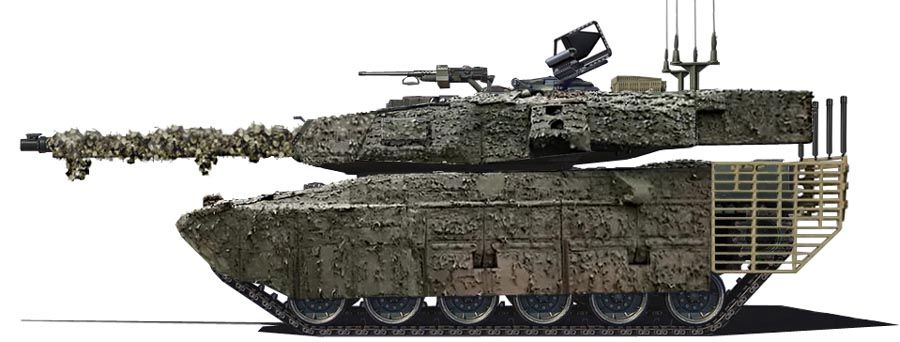 A CRAMUC (the Camp Roberts Armor Modification and Upgrade Centre) M60A5. This arsenal-depot depot has minimal design capabilities and simply installs upgrade kits.
A CRAMUC (the Camp Roberts Armor Modification and Upgrade Centre) M60A5. This arsenal-depot depot has minimal design capabilities and simply installs upgrade kits.
As shown, the new turret has been fitted armed with an M256 120 mm L/44 smoothbore ('recycled') from the M1 series upgrades to M256A2 L/55 guns (a former US Army M256E1). Secondary armament shown is an .50-cal M2A1 hatch gun and a hatch-mounted Droneshield anti-drone 'rifle' (RWS go on a fancier upgrade). A basic fit of drone jammers are mounted aft, attached to the slat armour 'cage’. Armour changes to the M60-2000 analogue are largely obscured by Barracuda-style signature suppressing camouflage system. Also covered by the camouflage matts are the bustle-mounted UAS and APS launchers.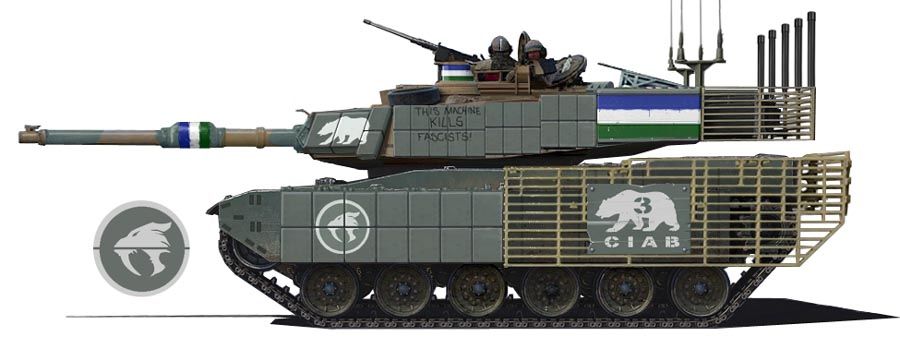 A MAMUC (Modesto Armor Modification and Upgrade Centre) M60A5 conversion.
A MAMUC (Modesto Armor Modification and Upgrade Centre) M60A5 conversion.
This vehicle belongs to the 1-3 Armor Bn - with the 1st Battalion's 'Smilodon' roundel marked on the forward track covers. The scheme, such as it is, consists of CARC green on all added panels (and also used to break up large areas of pre-existing FS 595 Sand paint). A quick ID of MAMUC conversions can be made by noting the greater area of hull slat armour (as compared with CRAMUC conversions).
This M60A5 carries the 'ID grizzly' in 5 x locations - 1 x rear (not visible here); 2 x front (over M19 ARAT-1 'bricks'); and 2 x side (on detachable panels attached to the slat armour). [1] NWF colours have been applied to the bore evacuator, commander's IR viewer housing, the Gunner's Primary Sight (not visible here), and on the APS/C-UAS launcher boxes. (The crew members in the hatches have also applied NWF coloured tapes to their helmets for out-of-vehicle recognition.)
The ERA tiles applied to the turret front and track covers are М32 ARAT-2s. On the turret sides are 4S22 Kontakt-5 ERA (donated to the NWF by the government of Ukraine). On some of those Kontact-5 'bricks', a crew member has scrawled 'This Machine Kills Fascists'.
______________________________________
[1] This ID panels were made by recycling highway signs (removed for security). Since the original sign boards were of sheet aluminum, these ID panels tended to show their wear quite quickly.M60ADVs (Air Defence Variants) - Due to a shortage of available M1 Abrams turrets, the M60A5s were not the only M60s returned to service and used by the NWF. That said, there were still plenty of useful hulls. Some were even used in their original format, typically in the support tank role. Others were more radical and included Air Defence variants. Also nicknamed as “Dementors”, these came in both gun and missile based versions. The gun variants were typified by those fitted with the German supplied Rheinmetall Skyranger 30 uninhabited turret fitted with 30mm KCE revolver cannon though it also has MBDA Enforcer V/SHORAD missile. The missile based versions came in many forms too, some with National/Norwegian Advanced Surface-to-Air Missile Systems (NASAMS) packs, others with systems such as the German IRIS-T. Perhaps the oddest were those fitted with variants of the old MIM-72 Chaparral system donated from Taiwan and Morocco. These were updated to use more modern AIM-9X missiles as well as Common Anti-Air Modular Missile (CAMM) missiles. Regardless of type, the M60ADVs proved invaluable in defending against Loyalist air and drone attacks.
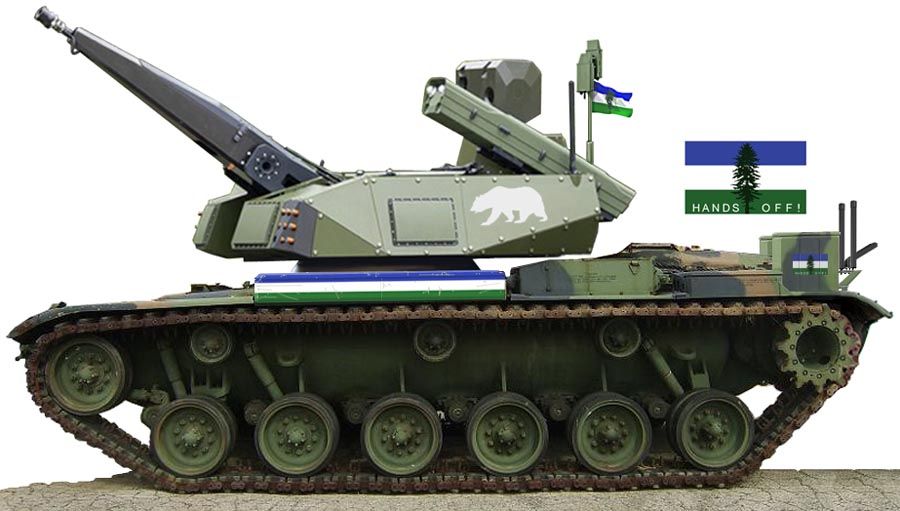
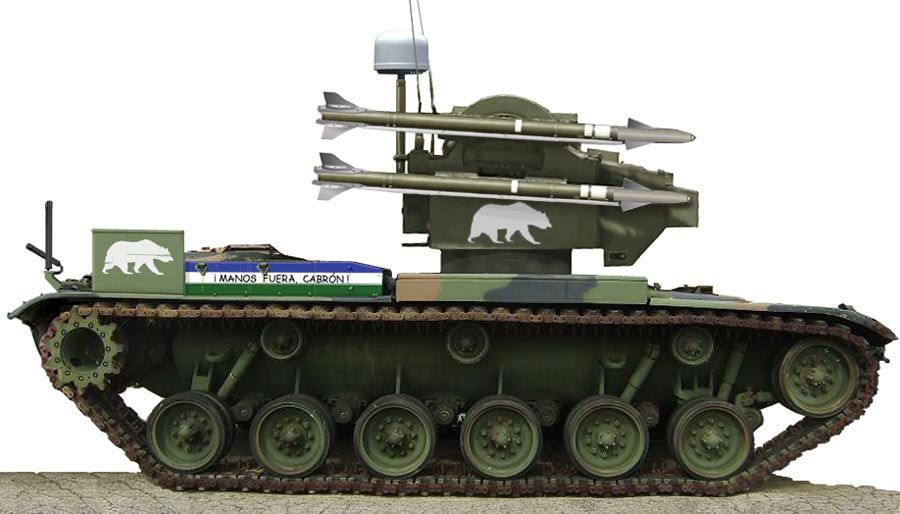 Stryker variants
Stryker variants - With over 4000 in service in the former USA, it was no surprise that many would find service with the NWF. Many were used in their traditional formats/roles. Some however were modified “Frankensteins” including:
- Stryker “Longclaw” - the first of the various Stryker variants introduced, this combined the standard Stryker 8x8 armoured vehicles with a AN/APG-78 Longbow radar and 8 pack AGM114 Hellfire missile launcher mounted atop an articulated arm sourced from civilian industrial boom lifts (though with some modifications to strengthen/enhance their lifting capacity). Sometimes also fitted with FIM-92 Stingers or other MANPADs, these provided an ability to extend the range of the normal weapons and allow NWF forces to also fight more effectively within some of the built-up areas. Development of these were greatly assisted by Canadian allies, especially in the form of the former General Dynamics Land Systems-Canada (GDLS-C).
- Stryker SP105 - this was a version inspired by the Stryker T7 Stryker 105 mm self-propelled howitzer but instead of the Denel 105 mm Towed Gun Howitzer used M68E1guns removed from converted M60A3 tanks converted to M60A5 configuration. The gun was mounted in a largely fixed mount and while far from ideal did provide NWF forces a useful self propelled howitzer/infantry fire support platform with a lot less complexity than platforms such as the old M1128 mobile gun system.
- Stryker “Reach” - the third Stryker variant to see wide spread use was also the result of Canadian GDLS-C support, this time in conjunction with the German company KNDS Deutschland. This took two existing Strykers and combined them to create the bigger 10 x 10 configuration. The rear was also cut them down at the back to allow fitment of the KNDS Deutschland RCH 155 Module carrying a 155mm howitzer. This resulted in a highly mobile system able to fire a burst of rounds and then able to rapidly move before retaliated against. Also fitted with the ubiquitous drone packs these vehicles were quickly given the name “Reach” based upon their RCH name and a play on the "Reach out and touch somebody” joke and/or “Reacher” Novels/Movies/TV show character.
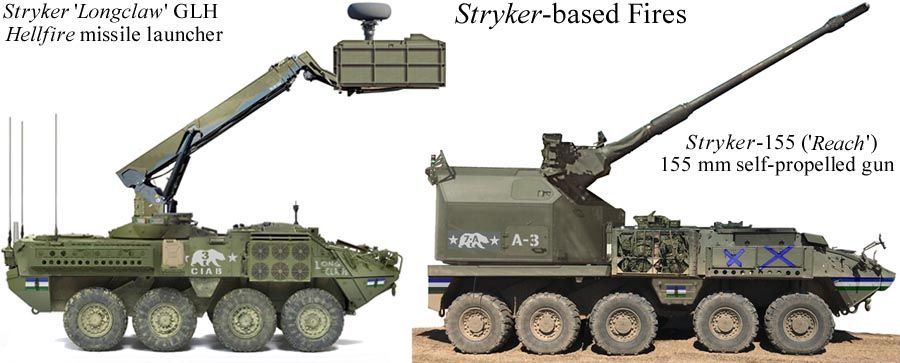
(Left) Stryker 'Longclaw' GLH (Ground Launched Hellfire) - an 8x8 hull (in this case, an M1128 MGS) fitted with an available 'Zoom Boom' lift arm to elevated an IHM (Integrated Hellfire Missile) platform. The latter combined twin 4-round missile launch boxes with an AN/APG-78 Longbow search and targeting radar system.
(Right) Stryker-155 (or ‘Reach') - a 10x10 hull created from reclaimed M1126 Stryker ICV hulls and components. The donated German turret systems were either the Rheinmetall RCH 155 or, as here, the KNDS AGM. The Stryker-155 was intended to provide a better-protected and more offroad mobile shoot-and-scoot platform than the civilian truck conversions mounting the RCH 155 turret.
M113 variants - As with other conflicts for the last 60 years, the venerable M113 found plenty of use in this conflict. Some were sourced from local stocks (in storage as well as former Army/National Guard) plus some donated from allies. While many were used in their traditional APC role, there were also a bunch specialised variants created by NWF forces. Some of these included:
- M113 Artillery variants: Both rocket and gun versions of the M113 found use. The former came in versions ranging from systems with single rocket tubes mounted on the rear through to some that made use of a complete MLRS adapted from a M142 HIMARS. In the case of gun versions, typically these used either towed 155mm M777s or 105mm M119s. There were even some SPH variants developed using variants such as the M113AS4 Armoured Logistics Vehicle (ALV) donated from Australia.
- M113 UGVs - last but, certainly not least were the numerous uninhabited ground and air platforms used by the NWF forces. Heaviest amongst these were the numerous M113 UGCV variants. Based upon the hundreds of M113 APCs liberated, these went by various names including "Terminator Turtles", “Autonomous Armadillos” or simply “Arnies". Able to operate either totally autonomously or in conjunction with manned platforms/infantry these would be seen operating all sorts of weapons, including auto mortars such as the Patria NEMO 120mm, or air defence variants with the Rheinmetall Skyshield 35mm system as well as many others.
 (Left) 'Mendocino Mutt' at speed. This tracked MLRS is an Australian M113 conversion armed with their locally-made GMLRS rockets. Based on the stretched M113AS4 hull, a HIMARS rocket module has been fitted. [1] These HIMARS pods became surplus Down Under when the ADF switched to South Korean K239 Woomera launchers firing 239 mm AGR-080 Gidjie guided rockets. NWF markings have been applied directly over the original hull's ADF camouflage scheme (which suited southwestern desert environments). The HIMARS component remains in its original olive drab (albeit in a well-worn and faded condition).
(Left) 'Mendocino Mutt' at speed. This tracked MLRS is an Australian M113 conversion armed with their locally-made GMLRS rockets. Based on the stretched M113AS4 hull, a HIMARS rocket module has been fitted. [1] These HIMARS pods became surplus Down Under when the ADF switched to South Korean K239 Woomera launchers firing 239 mm AGR-080 Gidjie guided rockets. NWF markings have been applied directly over the original hull's ADF camouflage scheme (which suited southwestern desert environments). The HIMARS component remains in its original olive drab (albeit in a well-worn and faded condition).
(Right) Another foreign donation - a Canadian hTLAV (hybrid-Tracked Light Armour Vehicle) conversion armed with a 105 mm piece as an ad hoc SP Howitzer. The reduced-height hTLAV hull [2] suited further conversion to SP mounts for donation to the NWF. This particular vehicle is slightly odd as it mounts a US M101 howitzer (rather that the more usual ex-Canadian Army C3 piece).
The experimental hTLAVs ceased to be useful for the Canadian Army once CV90-based CCV hybrids became operation. This hTLAV SP conversion retains its original, all-over CARC green finish. Somewhat non-standard NWF markings were applied at CFB Kamloops before being shipped south. (The chalked on 'A7' seems to be a Canadian mark as this vehicle had yet to be assigned to an active NWF unit.)
_______________________________________
[1] Under its domestic Guided Weapons Production Capability (GWPC), Australia made GMLRS rounds at Thales' Orchard Hills facility. Assembling GMLRS from Lockheed Martin-supplied, US-built components proved impractical once the White House began interfering with supply.
[2] The base hTLAV hull is from an experimental Canadian Army programme to test parallel hybrid system in military vehicles. Compared with the TLAV's parent vehicle, the hybrid conversion's ICE powerplant was mounted fore-and-aft and further back (allowing the hull to be cut down in height).
(Left) M68E1-gunned SP105 Stryker SP gun-how mod with cope cage added.
(Right) Donated M113AS4 ALV as ad hoc SP Howitzer. This is a fairly simple mod - with the vehicle carrying a palletised M119A3 (probably created after battle- or tow-damage of the piece's trail and/or wheels). This SP 'AS4 ALV is shown with its M119A3 rotated forward for firing. For transit, the gun would be rotate to the rear with elevation dropped to 10° or less. In combat, the SP would be accompanied by another 'AS4 ALV (or similar) to complete the gun crew and carrying replenishment rounds.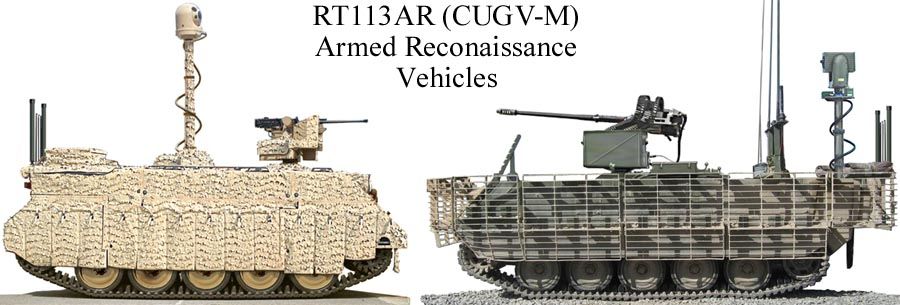 Although there were myriad variations on the UGV reconnaissance theme, there were two distinct forms of RT113ARs (CUGV-M Armed Recon). One was meant to stay hidden as much as possible. The other was intended to fight its way out of trouble.
Although there were myriad variations on the UGV reconnaissance theme, there were two distinct forms of RT113ARs (CUGV-M Armed Recon). One was meant to stay hidden as much as possible. The other was intended to fight its way out of trouble.
Were possible, the RT113AR wore composite track systems (such as donated Canadian Soucy CRT tracks). Such 'rubber band' tracks were quieter but also less maintenance intensive. The former provided an element of 'stealth' to moving RT113ARs, the latter was essential for vehicles which might spend a great deal of their time slowly manoeuvring into advantageous positions near to or even behind enemy lines.
(Left) A RT113AR 'recon-by-stealth' conversion prepared by the Irwin Army Depot in Barstow. [1] This vehicle has been fitted with a telescoping Will-Burt Stiletto mast topped by a donated Canadian Wescam E/O sensor. Boxes at the hull rear house an anti-drone ADS. Other defensive armament consists of a CROWS weapon system armed with an M2 Browning heavy machine gun. For tactical concealment, much of this RT113AR is clad in 'Grapevine' camouflage mats - a local copy of Swedish Barracuda thermal camouflage.
(Right) An RT113AR 'recon-by-saber' conversion prepared at the Fort Hunter Liggett Army Depot (HLAD). This vehicle was converted from a donated Canadian M113A3 TLAV (and retains a cut-down version of the bar armour 'fences' with which it was delivered). The main sensor is mounted on a Blue Sky MecMast (either a French donation or a captured unit). The main armament is an Australian EOS R-400S mounting a 30 mm M230 Bushmaster autocannon._____________________________________________
[1] Like most new Californian Army Depots, Barstow was chosen for a combination of rail access and available land. 'BarAD' was also chosen for its proximity to the Fort Irwin Armor Training Center (ATC) - formerly, a US Army National Training Center. A pair of armed escort M113A2 conversion variants. Both are BEV types with autonomous driving systems by Hermes Robotics. This pair would be designated RT113AEs as CUGV-M Armed Escorts.
A pair of armed escort M113A2 conversion variants. Both are BEV types with autonomous driving systems by Hermes Robotics. This pair would be designated RT113AEs as CUGV-M Armed Escorts.
These RT113AE conversions were fitted with whatever autocannons were available to the depot (similar armaments and calibres then being grouped for assignment to frontline units regardless of which depot produced the mod). Both RT113AEs wear T130E1 metal-link tracks (with available composite track systems largely held back for recon variants).
(Left) A RT113AE conversion prepared by the Humboldt Army Depot in Eureka. This vehicle is fitted with a donated Australian EOS R400 RWS armed with a lightweight 30 mm M230LF autocannon and a coaxial M240 GPMG. This RT113AE retains its base vehicle's ancient NATO Tri-colour camouflage (with cut-mark burns touched up in CARC green).
(Right) An RT113AE conversion prepared by the Bakersfield AD. Repainted in all-over CARC, this vehicle mounts a Valhalla Mangart turret armed with a 25 mm M242 Bushmaster and scabbed on coaxial C6A1 GPMG (with the remote-controlled turrets being Canadian-subsidised Slovenian donations). This 'BAD' RT113AE is a brand-new conversion (such that individual vehicle details chalked-on at the Depot are still visible beneath the flag decal). Other than that flag carrying very basic markings (although actual unit markings on CUGV-M escorts were unusual in any case).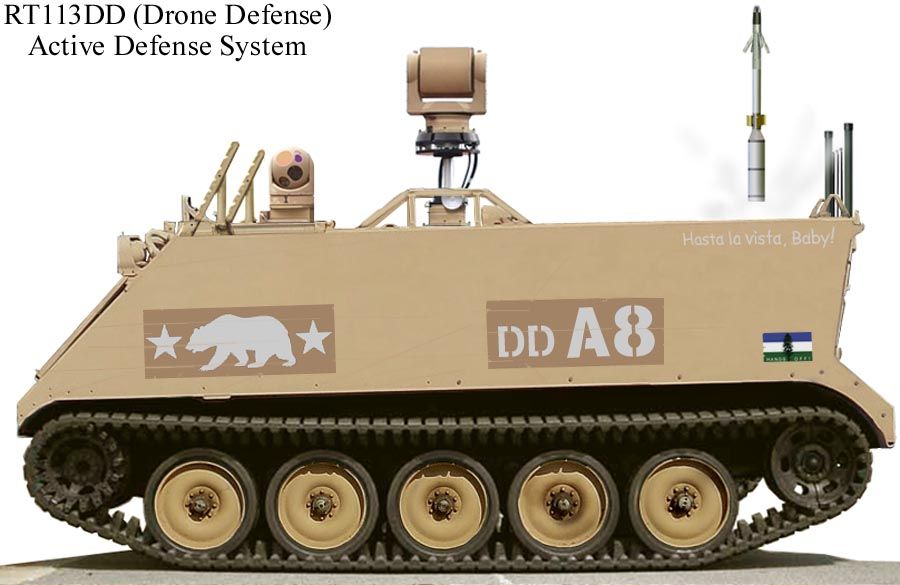 A 'full hull' RT113DD (Drone Defense) platform. Other than being BEV autonomous self-drivers, these vehicles differed little from the manned M113A3DD anti-drone launch systems.
A 'full hull' RT113DD (Drone Defense) platform. Other than being BEV autonomous self-drivers, these vehicles differed little from the manned M113A3DD anti-drone launch systems.
'DD variants are a GeoHot Defence development, combining comma.ai self-driving hardware with openpilot robotics operating system and a complete Wescam viewing/sensor/sighting system). This vehicle is unusual in that it wears Canadian Soucy composite tracks (suggesting that it may have been intended to accompany RT113ARs or other recon vehicles).
This RT113AD is seen in the process of loosing a Soft-Launch ADS by Evans Dynamics of Gawler, South Australia. The SL-ADS matches a short rocket body (based on the Hydra 70) with an APKWS seeker (laser or IR) and an 'air bag' Low Acceleration Launching System. The rest of the RT113DD's payload would be made up of shorter-range Hadrian Harpy interceptors.
These and other conventional/non-conventional, including simple civilian vehicles, allowed the NWF forces to provide more than a match for the Loyalist forces and to ultimately prevail in the war.
Oh, and the origin of the Brigade’s "No Wucking Forries” motto? This was adopted early on during the war as a result of some Australian volunteers fighting with the unit. Apparently as a play on the NWF acronym and their own willingness to take on challenging missions, they started acknowledging the acceptance of their orders with the response "No Wucking Forries mate!”. Very soon, it was being copied throughout the unit and soon became adopted as the unofficial, and later official unit motto.[/list]